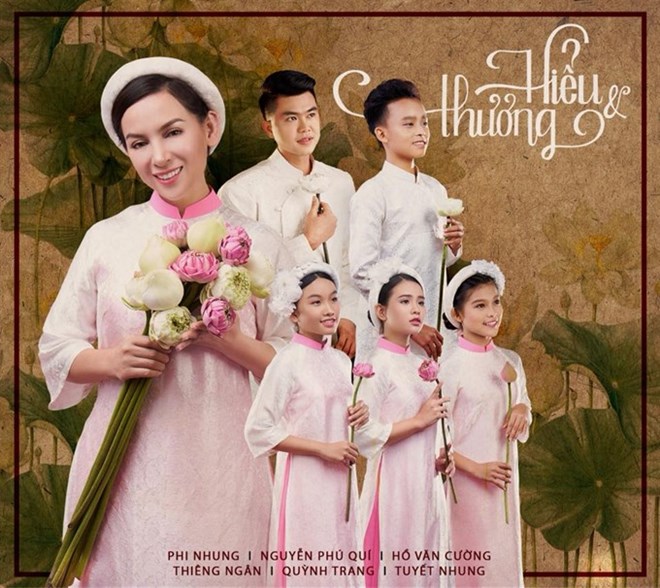
Vietnamese-American singer Phi Nhung, who has more than 20 years in the industry, will release an album to raise funds for poor children next week.

Cover of the album Hieu và Thuong (Understanding and Love) by
Vietnamese-American singer Phi Nhung (left) (Photo from the artist’s
facebook)
The album, Hieu va Thuong (Understanding
and Love), sends messages on love, sharing and compassion. It includes nine
songs in bolero, pop and folk contemporary music.
Featured songs are performed by Nhung and child singers Ho Van Cuong, Quynh
Trang, Pham Tuyet Nhung and Pham Thien Ngan.
Nhung was born in 1972 in the Tay Nguyen (Central Highlands) province of Pleiku
(now Gia Lai province). Her father was an American serviceman. She moved to
live in the US as part of its immigration policy towards Amerasians.
She began her career in 1989 in California and has worked with American and
French entertainment centres and music producers.
In 2005, she returned to HCM City and has released more than 200 solo and group
albums. Nhung runs her own charity fund for poor children.
Her concert, Phi Nhung Fan Meeting 2018, will take place at HCM City Youth
Cultural House on January 13.
The open-air event will feature dozens of guest singers, including pop star
Phuong Thanh and pop bands MTV and 5 Dong Ke.
Nhung will also pay for several hundred fans living in poor districts of
southern provinces to attend the event.
"I love singing for my young fans in my homeland," said Nhung.
"My daughter from the US will attend the concert and learn how much
Vietnamese fans love me," she added.
The show begins at 8pm at 4 Pham Ngoc Thach street, District 1. Entrance is
free.
More than 7,000 guests are expected to attend.
Source: VNA
Gongs hold a special place in the cultural and spiritual life of the Muong ethnic people in Hoa Binh province. More than musical instruments, they are an indispensable part of community rituals and collective memory, echoing through generations as a spiritual thread linking the past, present, and future.
Preserving and promoting the cultural values of the Muong ethnic group has become an urgent task in the current context, as many traditional values face the risk of fading away. This effort requires not only protecting the cultural identity but also eliminating outdated customs and developing a modern cultural lifestyle, contributing to sustainable values for the Muong community in Hoa Binh province.
The Muong ethnic culture, deeply rooted in Vietnam’s mountainous north, continues to be preserved and revitalised by dedicated individuals and communities determined to safeguard their ancestral identity.
The Muong group is one of the largest ethnic minorities in Vietnam, primarily found in Hoa Binh province. The Muong people in Hoa Binh boast a rich and diverse cultural treasure that reflects the unique identity of this ethnic group. Accounting for over 63% of the province's population, they have created and preserved numerous distinctive cultural values, contributing to their unique identity. Their cultural heritage is an invaluable asset, at the heart of their national identity, and represents a vibrant spiritual life that must be preserved and promoted in today’s modern world.
For generations, the ethnic communities of Hoa Binh province, particularly the Muong people, have preserved vibrant festivals deeply intertwined with the region’s geography, nature, and social traditions. These celebrations enrich Hoa Binh’s spiritual life and cultural identity, reflecting both folk beliefs and the intermingling of ethnic customs. Many of these festivals have endured the test of time, passed down through generations and continuing to thrive today. Among them, the Khai Ha (Going Down to the Field) festival stands out as one of the most significant events of the Muong ethnic group.
Muong calendar, known as sach doi, is an ancient folk knowledge system developed through observations of the movement of the pleiades star. This unique calendar consists of 12 bamboo sticks, each representing a lunar month. Specific days within each month are marked with distinct symbols, guiding locals in determining auspicious and inauspicious days for important activities.



